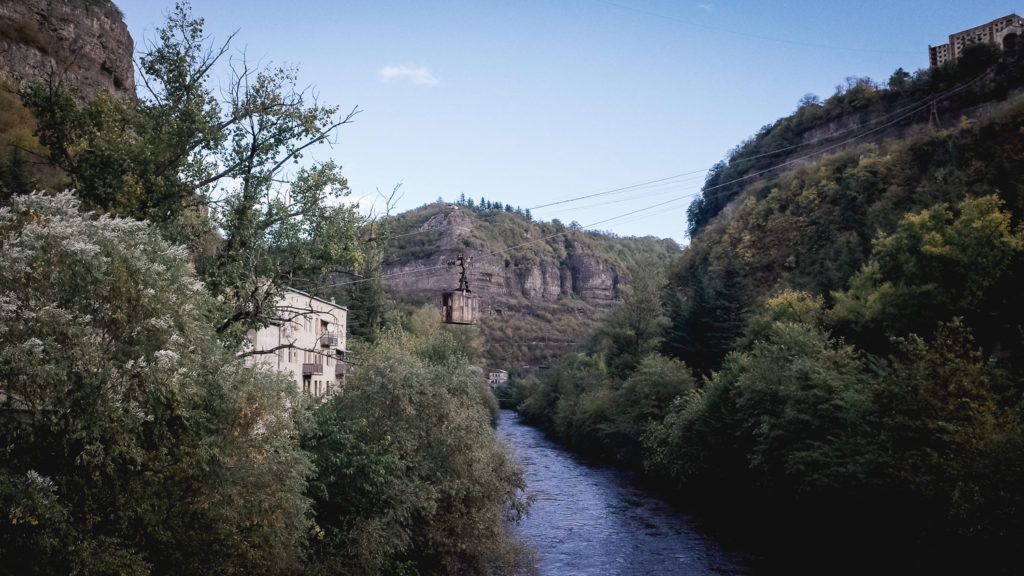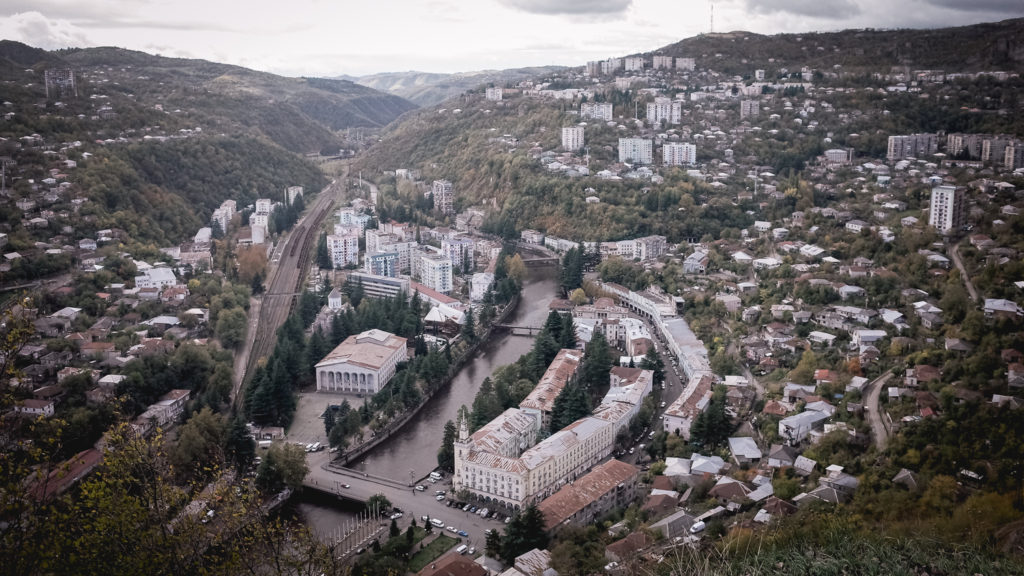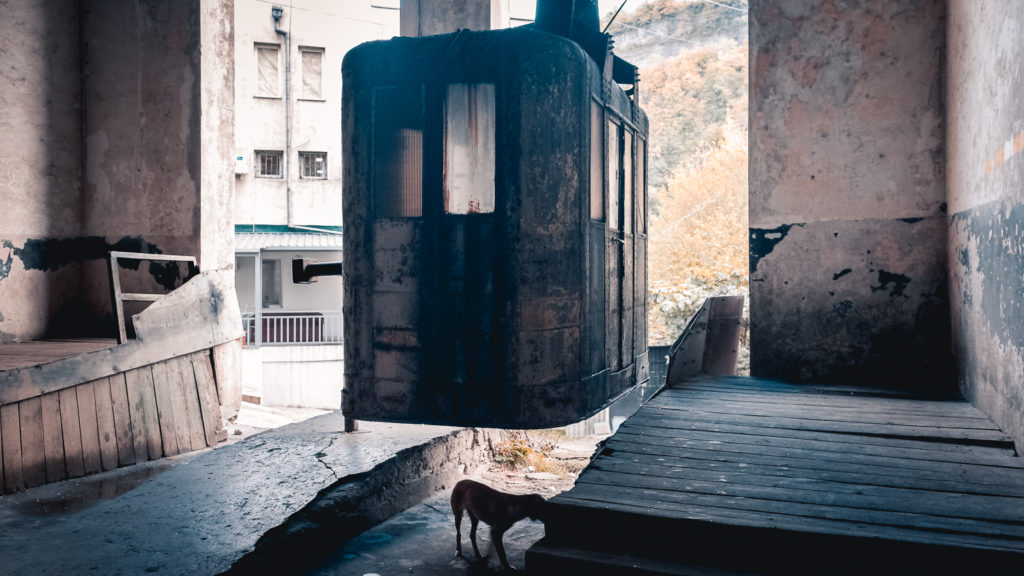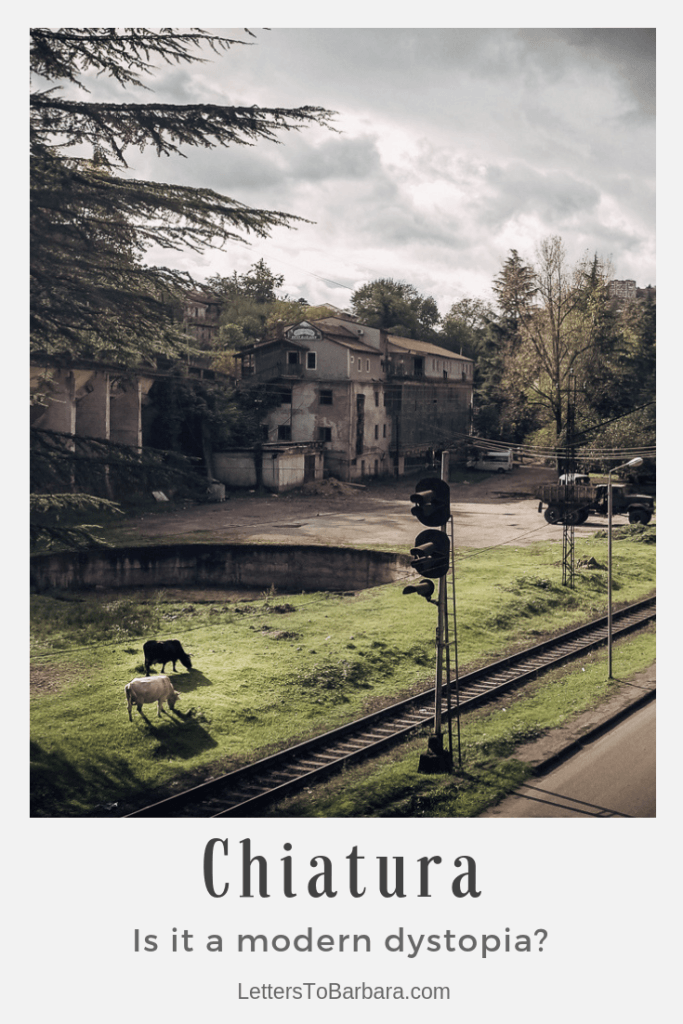Dear Barbara,
It’s a relatively long journey by car to Chiatura. It takes almost three hours, and I can observe both heavy rain and dazzling sunshine at the same time.
Chiatura is the place that brought me to Georgia. I have read about it, I have imagined visiting it, and I have failed to experience it earlier. But this year, the time was right, and when Luca started to drive, I knew that something outstanding was waiting for me.
Georgia’s nature is rich, and this makes the journey smoother. I know that you don’t believe what you read right now. I always complain that I find nature boring, and the only element that fascinates me is the sea. That’s right. I can assure you, though, that I didn’t experience a mutation while I’m in Georgia. But on a long journey by car, nature offers some sort of consolation.
Entering Chiatura

There is no prelude here, and no nice words can describe this place. An old Soviet sign welcomes the visitors to Chiatura -and then, Chiatura conquers you. At first, it seems like an eerie place: Chiatura is one of the largest manganese deposits in the world. I see some of the most run-down buildings I’ve ever seen, and people are wandering like sleepwalkers. They turn their heads towards Luca’s car, trying to identify if this vehicle belongs to the community. In such places, strangers resemble exotic birds.
On the main street, I see a cluster of interconnected apartment blocks. The ground levels of the buildings form some sort of passage, reminding me of the porticos of Bologna. But in Chiatura there is no Italian style, those arches are broken and gloomy. Street vendors gather daily there, selling whatever one might imagine. The inhabitants walk one by one in front of the merchandise, but they rarely buy something. They look, but they don’t touch.
I see men forming small groups. They are standing in front of cars and smoke endlessly. And then there are even more run-down buildings, some of them about to collapse. Dozens of floors and wet clothes hanging on the ropes under the sun. An older woman is following me with her eyes. She doesn’t talk to me, but when I turn my head after twenty meters, she is still staring at me.
The main avenue resembles a post-apocalyptic market. I wonder if a future sequel of Mad Max could take place in Chiatura. What’s the price of a product when it has no value?
The cable cars of Chiatura

But even the dystopian feeling of the main street cannot compete with the cable cars. Most of the manganese mines are on the cliffs, and you can only reach them by cable cars. In the 1930s, there were some ropeways; the cable cars that I see today have been introduced in the mid-50s. They are blue or silver, and some of them are still operating. Others are just hanging. They are old and rotten, and they don’t seem thicker than a tin can. The doors are not shutting properly; the windows are tiny and covered with some sort of net. They are really claustrophobic, and when the winds of Chiatura blow, the cable cars shake way too much.
Close to the bridge, I see the main station. There are currently two lines operating: one drives you to the top of the hill, while the other connects the two sides of Chiatura by crossing the river. The first line is offered for free, but in the other one, you have to pay for the ride. The maximum capacity of each cable car is seven people. To be fairly honest, I doubt that it can carry so much weight.
I hear the bell on the station, and then I listen to a woman’s voice. I don’t understand what she says, but I guess she calls the passengers to embark. She has a stern, formal tone when saying these words. It’s only me and Luca that enter the hanging coffin. Next to us, a bunch of Polish tourists claims that the whole thing seems too dangerous. “Risky,” says the only one of them that speaks English.
It probably is. But I think that if you start rationalizing what you are about to do, you will never enter. You will just remain on the platform looking at the cable cars arriving and departing. It seems like one hell of a ride.
Climb that windy hill

And all of a sudden, it starts. The blue cable car moves towards the top of the hill. It’s only a small set of ropes that holds it. Is this against the rules of physics? It’s not a smooth slide. As the cable car gains height, I start to feel dizzy. I try to look to the other side, but for some odd reason, I keep on looking towards the ground. Everything seems tiny, and the behemoth buildings look small now too. It’s dark inside the cabin, no lights or anything, and all I see through the circular windows, is Chiatura getting smaller and smaller.
The ride lasts for barely two minutes. But those minutes are dense, thick moments in time that I won’t forget. On the top of the hill, the cable car stops in front of an almost destroyed door. There is no protection or step between the cable car and the door; all you can see beneath is a chasm. The man working on the end station opens the cable car’s door and offers a hand. The hanging coffin is shaking like crazy because of the strong wind.
I exit, and I walk towards the square on the top of the hill. The view is magnificent. A miniature of Chiatura appears in front of me, and I see the cable car leaving. I take a couple of photos, I smoke, and then I wait for the next cable car.
Will we really make it?

I thought that the way down would be easy, but I’m wrong. As if the strong wind was not enough, it now starts to rain. The raindrops feel like bullets on the cable car’s body, and the cabin is shaky. Lucas and I laugh: “Are we gonna make it?” we ask ourselves, “Shall we jump?” It’s not funny at all, I can assure you, but we have to find the strength to cope with the situation.
The cable car speeds up. On the way down, it seems to be going much faster. I look again outside of the windows; the scale of the buildings is slowly re-established. The hanging coffin stops less than two minutes later, and when I open the door, the Polish tourists are still there. I nod them to have a ride, that it is okay. They nod back negatively with their heads.
Stalin’s shelter

Back in the day, Stalin used Chiatura as a shelter; later on, he turned the mines into a proper industry. Stalin himself was born just about an hour away from here, in Gori.
Today, Chiatura is not a ghost town, but neither an elegant one. I walk down the main street, and I observe the faces. There is past here, there is probably future, but all I see are faces keeping a secret. I have no idea what kind of secret that is, though. I have to return to Chiatura for sure.
We drive away from Chiatura, and I still have the growl of the hanging coffins in my ears. There are rumors that a Swiss company will replace those cable cars with brand new ones. I see a few of them hanging as we exit Chiatura. They are currently there, and in my mind, there will always be there.
You should see them one day -before it’s too late.
Yours,
George
More about Georgia: A monk above the clouds & A stream of hope in Tbilisi & Things to do in Tbilisi
Book your tour in Chiatura here
Travel better: Buy the camera I recommend | Book your hotel
Pin it!

Please share, tweet, and pin if you enjoyed reading Chiatura, a modern dystopia. Your support keeps this website running and all the info up-to-date. 🙂
Last Updated on June 20, 2020 by George Pavlopoulos

The description of the cable cars as “hanging coffins” and the dystopian feel of the streets is incredibly evocative. It’s fascinating how places steeped in history can hold such a mix of decay and beauty. Your experience riding the cable cars sounds both terrifying and exhilarating. I’m curious, did the locals you encountered share any stories or insights about living in such a unique place? This piece certainly paints Chiatura as a must-visit for those seeking the less-traveled path. Thanks for sharing such a captivating narrative.
Hey, thank you. Chiatura is indeed a unique place, and its atmosphere is really one-of-a-kind. Despite the language barrier, I managed to talk with some locals. To them, everything seemed regular. However, I believe that first-time visitors to Chiatura will be fascinated by its vibe. Although scary, a ride with the cable cars is a must-do when visiting this side of Georgia.